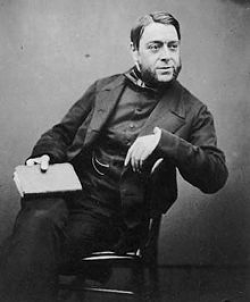Philip Henry Gosse

- Born
- 6 April 1810
- Died
- 23 August 1888 (age 78)
Philip Henry Gosse was one of the most famous naturalists of the mid-19th century. He contributed significantly to the development of the saltwater aquarium, wrote extensively about marine biology and the processes involved, along with illustrations that captured the public imagination and acted as an early sounding board for Darwin's theories on evolution.
Gosse was born in 1810 to miniature painter father, at a time when miniature portraits were going out of fashion, leaving the family in dire times financially. Raised in the seaside town of Poole he was heavily influenced by his Aunt Susan, who had a passionate interest in science.
At 17 he set sail for Newfoundland, and in his spare time, devoted himself to cataloguing the islands entomology. In 1932 he became enraptured by religion and deeply pious, something that would go on to play a significant role in the rest of his life.
Gosse left North America in 1939, after misadventures including a failed commune in Quebec and first-hand experience of the Alabama slave industry. Nonetheless, his time there fostered an enduring interest in nature. Upon his return, Gosse was virtually penniless, until the success of his 1940 book Canadian Naturalist.
He joined the Plymouth Brethren, a conservative Christian religious sect shortly afterwards. After writing two books, including the enormously popular The Ocean (1944) which spurred a sea anemone craze, he travelled to Jamaica. In his 18 months there, he collected specimens and drew illustrations of numerous tropical birds, which caused a sensation back in Britain.
It was after this that Gosse’s notoriety as a naturalist grew, with his charm to the public being the enthusiastic and exhilarating way he spoke about field biology. In many ways he could be described as the 19th century equivalent of a nature documentary maker.
In the 1850s Gosse coined the term ‘aquarium’ and sparked of a Victorian fad of keeping saltwater aquariums in the home in his 1954 book The Aquarium. While aquariums had been in existence for just over a decade, it was Gosse who truly popularised them and refined the technology involved.
Tragedy then struck Gosse when his wife, whom by most accounts he’d been very happily married to, died after a painful battle with breast cancer. In his grief, Gosse’s religion grew more prominent and he published what was by far his most controversial book Omphalos: An Attempt to Untie the Geological Knot (1957).
In Omphalos, Gosse suggested that geologic and fossil evidence that pointed to the earth being ancient was purposefully placed there to make it seem as if the earth was older than it actually was. Gosse contended more for geologic than biological evidence, due to Darwin’s Origin of Species being published two years after his book.
Unfortunately for him, the book was panned by scientific and religious authorities as being both unfalsifiable and slightly blasphemous, as it suggested God had lied. It was also unsuccessful with the general public. Nonetheless, it has ultimately proved influential in Creationist thought.



